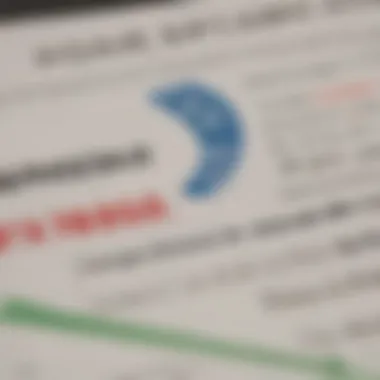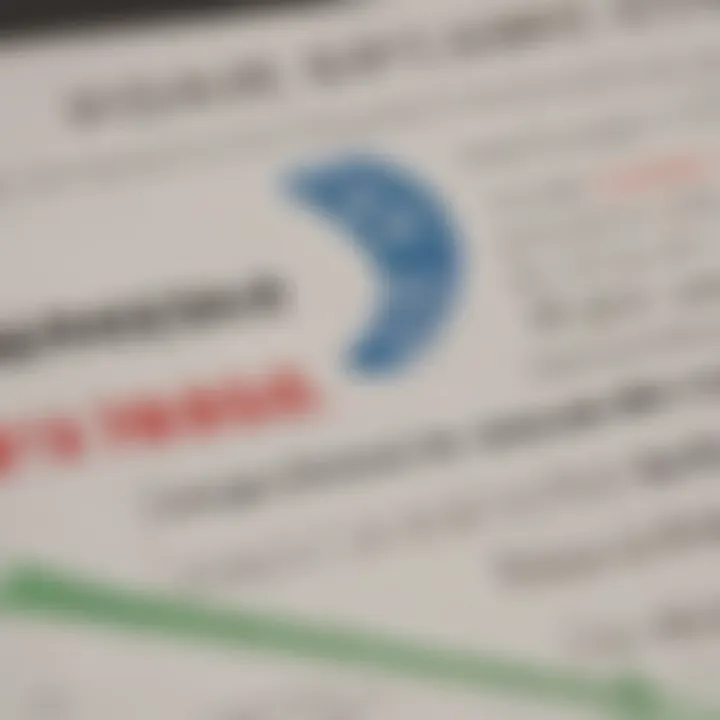Understanding Mortgage Refinancing Costs Effectively


Intro
Mortgage refinancing is a significant financial decision that many homeowners face at some point. Understanding what costs come along with this decision is crucial for making informed choices. The expenses associated with refinancing can substantially affect your overall financial health, from reducing monthly payments to potentially saving thousands over the life of the loan. In this article, let's shed light on these multifaceted costs linked to refinancing, empowering you to navigate the refinancing waters with clarity.
Investment Dictionaries
Understanding Key Terms
In the realm of mortgage refinancing, familiarity with essential terminology is invaluable. Here are some key terms that will aid in understanding the cost landscape:
- APR (Annual Percentage Rate): This reflects the total cost of borrowing on an annual basis, including the interest rate and any associated fees. It gives a more comprehensive view of what refinancing might cost over time.
- Closing Costs: These are fees incurred during the finalization of the refinancing process, typically including appraisal fees, title insurance, and attorney costs.
- Loan-to-Value Ratio (LTV): This ratio compares the amount of your mortgage to the value of your property. A lower LTV might get you better refinancing terms.
- Points: Paying points means paying interest upfront to lower your interest rate. Each point generally equals one percent of the loan amount.
Understanding these terms will help you interpret the costs associated with mortgage refinancing more effectively, enabling you to make strategic financial moves.
Common Investment Strategies
When considering mortgage refinancing, various strategies can help mitigate costs:
- Rate-and-Term Refinancing: This strategy involves changing your interest rate or the length of your loan without accessing equity. It can lead to significant savings if rates are lower than your original loan.
- Cash-Out Refinancing: This lets you tap into home equity, which can be useful for funding home improvements or consolidating higher-interest debts. However, be mindful of the additional debt you’re incurring.
- Streamline Refinancing: This option is available for certain loans, like FHA or VA loans. It often entails fewer paperwork and lower costs since it's designed to lower the interest rate for existing borrowers.
These strategies are not one-size-fits-all solutions. Evaluate each based on personal financial circumstances and long-term goals.
In-Depth Analysis of Investment Products
When delving into refinancing, scrutinizing the various products can provide insights into potential costs. For example, different lenders may offer varied interest rates or terms. It's valuable to compare offerings from institutions such as Quicken Loans, LoanDepot, and Wells Fargo.
- Lender A: Offers a lower interest rate but higher closing costs.
- Lender B: Higher interest rate but lower associated fees.
By assessing these options, you can identify which product aligns best with your refinancing goals while minimizing costs.
Synthesizing the Information
Understanding the costs of mortgage refinancing isn’t just about crunching numbers. It involves evaluating how these choices affect you in both the short and long term. Moving forward without a clear perspective could lead to overspending or missing out on financial opportunities. Equipped with this knowledge, you can confidently approach refinancing, ensuring that your decision-making process is grounded in thoughtful analysis.
"The best way to predict the future is to create it."
As you ponder refinancing, remember that it’s not solely about immediate savings but about aligning your lending strategy with your financial aspirations.
Preface to Mortgage Refinancing
Navigating the world of mortgage refinancing can often feel like stepping into a maze with its myriad options and costs. Understanding this topic is paramount for anyone considering making the leap. Refinancing a mortgage entails taking out a new loan, ideally with more favorable terms, to pay off the existing one. At first glance, the concept seems straightforward; however, several nuances dictate how one can maximize benefits and minimize costs.
Key Points of Importance
Mortgage refinancing might just be the financial maneuver that allows homeowners to leverage current market rates, offer them additional liquidity, or consolidate debt more effectively. Knowing the landscape can spell the difference between financial distress and security. When approached judiciously, this decision can significantly enhance cash flow or reduce long-term interest expenses. However, there are costs associated that, if overlooked, can impact one’s fiscal position.
Benefits of Refinancing
Refinancing enables homeowners to modify the terms of their mortgage, potentially lowering monthly payments or enabling access to cash through home equity. Whether you’re seeking to lower that interest rate or to shorten the loan term, the implications can be profound. Homeowners can also shift between fixed and variable rates according to their financial strategy.
Key Considerations
Before diving headfirst into refinancing, it’s crucial to consider factors such as the current interest rate climate, personal eligibility, and overall financial health. Have you taken the time to assess your credit score recently? This could be a game-changer in determining the type of rates for which you qualify. Furthermore, evaluating your current debt-to-income ratio can give insight into how refinancing will affect your overall financial strategy.
"Refinancing without due diligence can be like gambling with your future—it might pay off, but the odds can be against you. "
Ultimately, understanding mortgage refinancing is not simply about chasing the lowest rate. It's about grasping the entire financial picture. The succeeding sections will provide a thorough breakdown, focusing on the costs involved, which can sometimes catch people off guard. By being well-informed, individuals can make decisions that are not only economically sound but also strategically advantageous in the long run.
The Cost Breakdown of Refinancing
Application Fees
When you apply for mortgage refinancing, lenders typically charge an application fee. This fee acts like a ticket to the show – it gets you into the underwriting process where the lender starts to evaluate your financial situation and creditworthiness. Generally, this fee can range from $300 to $600, depending on the lender.
One key thing to keep in mind is that the application fee is often non-refundable. If your application gets denied, you might not see that cash back. Hence, it's wise to ensure your financial ducks are in a row before you send in that application.
Some lenders may waive this fee or roll it into the closing costs, so it's always a good idea to shop around. Asking for clarity on every charge will help you avoid any surprises down the road.
Appraisal Fees
An appraisal is essential in the refinancing process. This fee usually falls between $300 and $700, but it can climb higher depending on the property's complexity and location. Lenders want to ensure that the property's value supports the loan amount you're asking for, which is why a professional opinion is needed.
The appraisal ensures the lender protects its interests. However, for you as a homeowner, a higher appraisal could work to your advantage by potentially providing more equity. Conversely, a low appraisal might lead to the lender refusing the loan or asking for additional guarantees. In this case, it pays off to have a property in good shape and maybe even toss in some aesthetic improvements beforehand.
"Investing in your property's appearance before an appraisal can yield dividends later".
Credit Report Fees


The credit report fee is another cost that might slip under the radar. Generally, lenders will obtain your credit report and pass that fee – often around $30 to $50 – onto you. This report plays a critical role in the refinancing decision, as it gives lenders insight into your credit history and score.
By maintaining a good credit score, you might not just safeguard your chances of refinancing but can also secure better interest rates. Keep in mind that different lenders may approach this fee differently; some may even cover it if you refinance with them. Understanding this fee is pivotal as it contributes to the overall picture of costs involved.
In summary, breaking down the costs associated with refinancing exposes potential financial hurdles while also highlighting opportunities for savings. Every cent counts in making a well-rounded decision, especially when navigating a financial landscape as intricate as mortgage refinancing.
Closing Costs Explained
Understanding closing costs is fundamental when diving into mortgage refinancing. These costs represent a significant part of the refinancing equation and can greatly affect your overall financial outcome. When you take this route, you’re not only looking to lower your monthly payments or change your loan terms, but you are also stepping into a realm of fees and costs that can be both expected and unexpected. A clear grasp of these closing costs allows borrowers to navigate this complex financial landscape more effectively.
Understanding Closing Costs
Importance of Closing Costs
Closing costs are the fees associated with finalizing a mortgage refinance. They typically range from 2% to 5% of the loan amount, depending on several elements like your location, lender, and the complexity of your financial situation. Understanding these costs is crucial because they can significantly impact your decision to refinance. The importance lies in realizing that while refinancing can lead to long-term savings, the upfront costs can sometimes negate those savings if not carefully evaluated.
For instance, if your closing costs amount to $5, but you only save $200 a month on your payments, it could take more than two years to break even on your refinance. Thus, understanding how closing costs play into the larger picture allows borrowers to make sound, informed decisions.
Factors Influencing Closing Costs
Several factors can sway the closing costs associated with refinancing. The type of loan, the experience of the lender, the location of the property, and even the borrower’s credit score can all play roles in defining these costs. Different loan programs have unique requirements, and that can lead to variations in costs. For example, a conventional loan might charge different fees than a federal-backed loan.
A key characteristic of these influencing factors is their variability. Not only can they differ from one lender to another, but they can also change based on market conditions. During low interest rates, some lenders may reduce fees to attract more loans, while in a competitive market, borrowers could encounter increased expenses.
To tackle these costs intelligently, those interested in refinancing should shop around, comparing quotes from various lenders to ensure they get the best deal possible.
Typical Closing Costs for Refinancing
When refinancing a mortgage, some of the most common closing costs include:
- Loan Origination Fee: Charged by the lender for processing the new loan.
- Title Insurance: Protects against any potential missteps in property ownership.
- Escrow Fees: Charges related to maintaining an escrow account for taxes and insurance.
- Inspection Fees: Payments for home inspections to assess property condition.
Each of these costs contributes to the overall financial picture and underlines the necessity for potential refinancers to do their homework. Knowing what to expect and where to scrutinize can make all the difference in making mortgage refinancing a beneficial move.
Interest Rates and Their Impact
When delving into mortgage refinancing, one cannot overlook the crux of the issue: interest rates. These rates significantly influence not only the initial costs of refinancing but also the long-term financial implications for homeowners. Understanding how interest rates operate can lead to far better decision-making in regard to refinancing options. It’s not just about securing a lower rate; grasping this aspect ensures that individuals weigh overall savings against future costs effectively.
How Interest Rates Affect Refinancing Costs
Interest rates serve as a compass guiding not only the immediate affordability of a refinance but also the entire structure of monthly payments and the total cost over time. A lower interest rate not only reduces the monthly payment but also can significantly cut down the total interest paid over the life of the loan. Here's how:
- Monthly Payments: A lower rate typically means lower monthly payments. For example, refinancing from a 5% to a 3.5% interest rate on a 30-year loan can save a borrower a considerable sum monthly.
- Total Interest Paid: Over the term of the loan, a small reduction in interest can translate to tens of thousands of dollars saved. To put this in perspective, on a $300,000 mortgage, even a 1% reduction can amount to nearly $60,000 in interest savings over 30 years.
- Break-even Point: Understanding your break-even point — the point at which your savings exceed your refinancing costs — is intricately tied to the interest rate. If rates are low, you may reach that threshold faster.
Types of Interest Rates in Refinancing
In the world of refinancing, homeowners generally encounter two primary types of interest rates: fixed and variable. Each of these has unique features worth considering.
Fixed Rates
Fixed rates affix a borrower's interest at the loan’s inception, guaranteeing stability over its term. This stability presents a certain allure for those who prefer predictability in their financial planning.
- Key Characteristic: The ability to lock in an interest rate means that regardless of market fluctuations, the borrower's payment remains constant. This predictability protects against any surprises, particularly during economic downturns.
- Advantages: For those who plan to stay in their homes long term, a fixed rate can offer significant peace of mind. This structure allows for easier budgeting: if you know that your mortgage payment won’t change, you can allocate your funds more effectively.
- Disadvantages: However, the price for this security can sometimes be higher average rates compared to variable options.
Variable Rates
On the flip side, variable rates, also known as adjustable-rate mortgages (ARMs), adapt according to the prevailing interest rates in the market. This feature can work for or against borrowers, depending on market trends.
- Key Characteristic: Initially, variable rates may start lower than fixed rates. Typically, they provide an enticing lower monthly payment upfront compared to their fixed counterparts.
- Advantages: If market rates decline, the borrower benefits without having to refinance. This aspect makes variable rates appealing, especially for those considering short-term stays.
- Disadvantages: The uncertainty involved can make them daunting. If interest rates rise, so too do mortgage payments, potentially leading to payment shock for some homeowners.
The decision between these types of interest rates is personal, hinging on the borrower’s financial situation and their outlook on the market.
Understanding how interest rates impact refinancing costs and the choice between fixed and variable rates can provide significant leverage in navigating the refinancing process. Ultimately, it’s about aligning these choices with individual financial goals.
Potential Savings from Refinancing
When it comes to mortgage refinancing, many homeowners are enchanted by the promise of potential savings. This can seem like a golden ticket, but it's crucial to peel back the layers and really take a look at what those savings entail. This section dives into the importance of understanding potential savings because it sets the stage for informed decisions amidst the labyrinth of costs and fees.
Refinancing can lead to significant reductions in monthly payment amounts. Yet, it's more than just a number on a bill; it plays a substantial role in long-term financial health. Potential savings can stem not only from lower interest rates but also from various strategies like shortening loan terms or leveraging home equity. Whether you’re trimming your budget for better financial freedom or planning for big life events, knowing the ins and outs of these savings is essential.
Long-term vs. Short-term Savings


In the world of mortgage refinancing, differentiating between long-term and short-term savings is akin to choosing between apples and oranges; both can be beneficial, yet they serve different purposes. Short-term savings often refer to immediate reductions in monthly mortgage payments, which can relieve your financial burdens almost instantaneously. However, paying attention to whether these immediate savings come at the cost of extended loan terms or increased total interest amounts over time is key.
On the flip side, long-term savings provide a more sweeping view. For instance, refinancing to a lower fixed-rate mortgage can lead to substantial savings over the life of the loan. In some cases, a borrower might opt to refinance with a 15-year instead of a 30-year mortgage, which can mean higher monthly payments but lower overall interest costs, effectively reducing the total amount paid.
A quick comparison:
- Short-term:
- Long-term:
- Reduced monthly payments
- Improved cash flow for immediate needs
- Lower total interest paid
- Builds equity faster
Many homeowners fall into the trap of focusing solely on immediate savings when refinancing, often overlooking the bigger picture. Recognizing both angles will empower you to make strategic choices that align with your financial goals.
Calculating Potential Savings
Calculating your potential savings from refinancing isn't just some shot in the dark; it’s rooted in specific values and projections. To get a clear perspective, you might want to start by evaluating your current mortgage terms. Gather pertinent numbers like your current interest rate, loan balance, and remaining loan term. Compare these with the available refinancing options.
For calculating potential savings, you can use a simple formula:
- Determine your current monthly payment using your existing loan information.
- Find out your new loan payment based on refinancing terms.
- Subtract the new payment from the existing payment to find monthly savings.
For example, if your current payment is $1,500 and your new payment will be $1,200, your monthly savings is $300.
Next, multiply your monthly savings by 12 to gauge how much you could save over a year. It’s also smart to examine how many months it will take to recoup the costs incurred during the refinancing process, such as closing costs or other fees. This gives you insight into whether refinancing makes financial sense.
In summary, calculating savings enables a clearer path toward financial literacy regarding refinancing. Knowing the figures not only curtails impulsive decisions but allows homeowners to act with greater confidence in their financial journeys.
Hidden Costs You May Not Consider
Mortgage refinancing often sounds like an excellent idea to reduce monthly payments or lower interest rates. However, there are hidden costs that can catch even the most diligent homeowner off guard. Understanding these costs can be the difference between a savvy financial choice and a costly misstep. These nuances can alter your financial landscape significantly, so let’s dig deeper into what you need to keep in mind.
Prepayment Penalties
One of the less-discussed aspects of refinancing is the potential prepayment penalties that might be tacked onto your existing mortgage. These penalties are essentially fees that some lenders impose if you pay off your loan early. It might seem odd to penalize someone for taking the initiative to pay off debt, but this fee exists to protect the lender's financial interests. Before you dive into refinancing, it's crucial to peek at your original mortgage agreement to see if it has this kind of clause.
The amount of a prepayment penalty can vary greatly. It might be a flat fee, say, 1-6 months of interest payments, or it could be structured as a percentage of the remaining balance. For instance, if you still owe $200,000 on your mortgage, a prepayment penalty of 3% would cost you $6,000 if you refinance too soon.
To avoid such surprises, always discuss this topic with your lender. Here’s why it's transformative:
- Budget Planning: Knowing your potential penalties helps in valuing your overall financial strategy.
- Right Timing: It might influence your timing in refinancing,
- Cost-Benefit Analysis: This fee can offset the benefits of refinancing so weigh the costs carefully.
Escrow Fees
Next up are escrow fees, another hidden cost that can sneak up on borrowers during refinancing. When you refinance, you might need to establish a new escrow account, which is designed to hold funds for property taxes and insurance premiums. The establishment and management of this account usually come at a cost.
These fees can vary widely; they typically range from a few hundred to a few thousand dollars. Here’s what to consider regarding escrow fees:
- Service Provider Differences: Different lenders have different policies on escrow accounts. Some may charge higher fees based on their services, while others are more lenient.
- Annual Escrow Analysis: Most lenders will perform an annual analysis of your escrow account to determine whether the collected amount suffices to cover your property taxes and insurance. If not, this discrepancy can lead to increased payments moving forward.
- One-Time Charges: In many instances, you may have to front an initial deposit to ensure sufficient funds are available in the escrow account, leading to immediate costs when you refinance.
To sum it up, while refinancing often appears advantageous, it's vital to factor in these hidden costs. Ideally, you should evaluate the bigger picture before signing on the dotted line, weighing both immediate and long-term financial implications.
Tax Implications of Refinancing
When diving into the world of mortgage refinancing, understanding the tax implications serves as an essential part of the conversation. Many homeowners assume that everything about refinancing is straightforward, but there are layers to peel back. The decisions you make could impact your tax situation significantly—sometimes positively, sometimes not so much.
Foremost among these tax considerations is the deductibility of mortgage interest. When you refinance, the interest you pay on your new mortgage could potentially be deductible. This is particularly beneficial if the new mortgage amount exceeds the old one, as homeowners might be eligible to deduct the additional interest. However, it's crucial to ensure that the refinancing purpose aligns with your tax strategy, as personal financial situations can vary widely.
Moreover, many homeowners overlook the possibility of capital gains implications. Refinancing to improve your property can sometimes entangle you in unexpected tax liabilities when it's time to sell. Understanding how these factors interplay can help avert unpleasant surprises down the line.
"Navigating the tax implications of refinancing isn't just about immediate savings; it's about long-term financial health."
Understanding Tax Deductions
Homeowners should familiarize themselves with potential tax deductions when refinancing. The IRS allows taxpayers to deduct certain costs associated with mortgage interest, making it advantageous for homeowners, especially those in high-interest states. Primarily, if your mortgage was used to buy, build, or substantially improve a home, interest may be fully deductible, subject to IRS rules.
In cases where funds are pulled from a refinance for other uses—say, paying off credit card debt or funding a vacation—this may not qualify for deduction against your primary mortgage. This distinction is crucial. It leads many to miscalculate potential tax savings, thinking they can ride on benefits that just aren't there. Keeping an eye on your documentation is also worthwhile to ensure that deductions align with IRS requirements.
To dig even deeper, homeowners should realize that there are limits on the total amount of mortgage debt eligible for interest deduction. As of now, the cap stands at $750,000 for loans taken out after December 15, 2017. You might also want to consider state tax responsibilities, as local regulations vary, and they can throw a wrench in federally deducted amounts.
Capital Gains Considerations


Next on the list of significant factors is understanding capital gains considerations during refinancing. When you choose to refinance, it may lead to a more substantial gross profit when you sell the property later on. This is particularly true if you've made considerable improvements funded by the refinance. However, what many overlook is that the IRS typically regards gains from the sale of a primary residence as taxable, over a certain threshold.
As it stands, if your profit exceeds $250,000 (or $500,000 for married couples), you'll owe capital gains tax on that excess amount. Capital gains tax can eat into any profit, so refinancers need to plan accordingly. For instance, if you're investing tens of thousands into renovations—thanks to boosted equity from your refinance—make sure you are prepared for the tax implications when the time to sell arrives.
In summary, the intricacies surrounding the tax implications of refinancing can shape your financial future significantly. Strengthening your understanding of tax deductions and capital gains can empower you to make decisions aligned with your financial goals. Always consider consulting with a tax professional to navigate the labyrinth of regulations and ensure that your handling of refinancing works in your favor.
Alternatives to Mortgage Refinancing
When the topic of refinancing arises, it’s often met with a mixture of enthusiasm and caution. Homeowners typically see refinancing as a golden ticket to lower rates or better terms. However, it’s vital to consider alternatives. In this section, we will dive into two notable alternatives: Home Equity Loans and Home Equity Lines of Credit (HELOC). Both options present unique benefits and potential pitfalls that deserve thorough discussion.
Home Equity Loans
Home equity loans allow homeowners to borrow against the equity they’ve built in their property. In essence, if you’ve been paying off your mortgage for a few years, you might have accumulated equity that you can leverage. This type of loan is typically disbursed as a lump sum with a fixed interest rate, making it a transparent option for those looking for a straightforward way to tap into their home’s value.
The primary advantages of home equity loans include:
- Fixed Rates: These loans often come with fixed interest rates, allowing borrowers to plan their budgets more easily.
- Lump Sum Payment: You receive the full amount upfront, which can be beneficial if you have a significant expense in mind, such as consolidating debt or financing a substantial project.
- Tax Deductible: Under certain circumstances, the interest might be tax-deductible, adding a layer of attractiveness for financially savvy individuals.
However, potential drawbacks exist:
- Collateral Risks: If you default, you risk losing your home, since it is put up as collateral.
- Fees and Costs: Just like with refinancing, there can be various fees associated, including origination fees.
Home Equity Lines of Credit (HELOC)
A HELOC operates somewhat like a credit card, allowing homeowners to borrow against their home’s equity but in a revolving fashion. This means you can draw money up to a predetermined limit, pay it back, and then borrow again—similar to how a credit card functions. Interest rates on HELOCs are usually variable, making this option more flexible but potentially more unpredictable.
Some notable benefits of a HELOC are:
- Flexibility: You borrow only what you need when you need it, making it ideal for ongoing projects or expenses, like home renovations or unexpected medical bills.
- Interest-Only Payments: Many HELOCs allow for interest-only payments during the draw period, which can keep monthly costs low.
- Potential Tax Benefits: Similar to home equity loans, the interest might also be tax-deductible.
That said, there are considerations to keep in mind:
- Variable Rates: The uncertainty of variable interest rates can make budgeting more challenging.
- Draw Periods: There are specific terms that dictate borrowing, and repayment starts after the draw period ends, which could mean higher payments.
Both home equity loans and HELOCs can be powerful financial tools, providing flexibility and access to necessary funds without the complexities of refinancing. However, understanding their nuances and risks is essential for making informed choices.
In summary, before jumping headfirst into refinancing, homeowners should reckon these alternatives seriously. Not only do they offer ways to access funds, but they do so under different sets of financial rules, merits, and downsides. This careful evaluation can lead to better long-term financial stability.
Evaluating Whether to Refinance
Evaluating whether to refinance a mortgage is like weighing different ingredients when cooking a new recipe. You want the end product to taste just right, but each ingredient can change the flavor completely. In this context, one must carefully assess the costs and benefits that stem from refinancing choices, as these decisions can significantly influence future financial stability.
As mortgage rates continue to change, homeowners must stay attentive. This means not only considering current rates but also reflecting on personal circumstances, as factors like credit score and home equity play vital roles. Moreover, the whim of the market can either push you toward refinancing or make you rethink the need altogether. Each homeowner’s scenario is as unique as a fingerprint, making it critical to take a personalized approach when evaluating whether to refinance.
Key Considerations for Refinancing
Before jumping into the refinancing pool, it’s crucial to examine a few pivotal aspects:
- Current Interest Rates: A significant motivation for refinancing is the chance to secure a lower interest rate. Keep an eye on trends and forecasted changes in the market. Remember, even a small dip can lead to considerable savings.
- Loan Term: Think about how long you plan to stay in your home. Shorter loan terms often mean higher monthly payments but can save you on interest over time.
- Current Equity and Credit Score: Your equity determines how much you can borrow, and a higher credit score often grants access to better rates. If your finances have improved since obtaining the mortgage, it could be a good time to refinance.
- Cost of Refinancing: The up-front expenses can include application fees, appraisal fees, and closing costs, among others. Take a moment to calculate whether the savings outweigh these costs over time.
Evaluation should not be a hasty affair; rather, it requires a measured approach where all elements align logically to guide a decision that might impact one’s financial future.
When Refinancing is a Bad Idea
Even with all the talk around the conveniences that refinancing brings, it is not a universal solution. Here are some situations where refinancing might not be your best bet:
- High Closing Costs: If the fees are substantial compared to the savings, the deal does not make financial sense. Always consider your break-even point—when the savings from a lower rate will exceed the costs incurred to refinance.
- Uncertain Future: If you are planning to move soon, refinancing might lead to costs you won't recoup. On the flip side, an adjustment could make your payments burdening.
- Credit Score Issues: If your credit score has taken a hit since you got your original loan, you might not qualify for a favorable rate. In this case, it may be wiser to wait until your score improves.
- Prepayment Penalties: Some original loans contain stipulations that impose penalties for paying off the loan early. Check your agreement thoroughly; refinancing could result in unexpected fees.
Finale
In wrapping up our exploration of mortgage refinancing costs, it's critical to take a moment and reflect on the myriad details we've covered. Understanding the financial tapestry of refinancing not only arms individuals with information but also shapes their decision-making process. The costs, while sometimes daunting, can pave the way for significant long-term savings and other benefits.
Summarizing the Costs and Benefits
When you look at refinancing, the picture is a little mixed, like a jigsaw puzzle missing some pieces. On one hand, you have the upfront costs: application fees, appraisal fees, and various closing costs that can add up quickly. These expenses can feel heavy, almost like a lead weight pulling you down. However, the potential benefits are worth considering. Lower interest rates can reduce monthly payments, leading to substantial savings over time. Additionally, refinancing can help you access your home equity or better align your mortgage with your current financial goals.
- Direct savings: Monthly payments could ease your financial burden.
- Home equity release: Extra cash for investments or major purchases.
- Long-term benefits: Potential to build wealth or enhance cash flow.
Ultimately, the calculus of costs versus benefits will depend heavily on individual circumstances, interest rates, and market conditions. Getting into the nitty-gritty details, such as understanding how long it will take to recoup refinancing costs through savings, becomes fundamental. Make no mistake; this decision requires careful thought and consideration.
Final Thoughts on Mortgage Refinancing Decisions
Navigating the mortgage refinancing landscape can feel like walking a tightrope. There are many factors at play. The decision to refinance hinges not just on the obvious numbers but also on your broader financial landscape. It’s important to ask yourself questions like:
- How long do you plan to stay in your current residence?
- Are you aware of the hidden costs that may crop up unexpectedly?
- Do you have a solid strategy in place for the potential tax implications?
By taking the time to think through these elements, you're less likely to find yourself in murky waters later on. Engaging professionals, like financial advisors or real estate experts, can provide invaluable perspectives tailored to your unique situation.
In summary, mortgage refinancing can be a savvy financial move, provided you navigate the costs thoughtfully and align them with your long-term goals. The road to refinancing should not be taken lightly; it requires both strategic thinking and informed choices. The journey may seem daunting at first, but like any worthwhile endeavor, it has its rewards, making it essential to weigh each step carefully.



